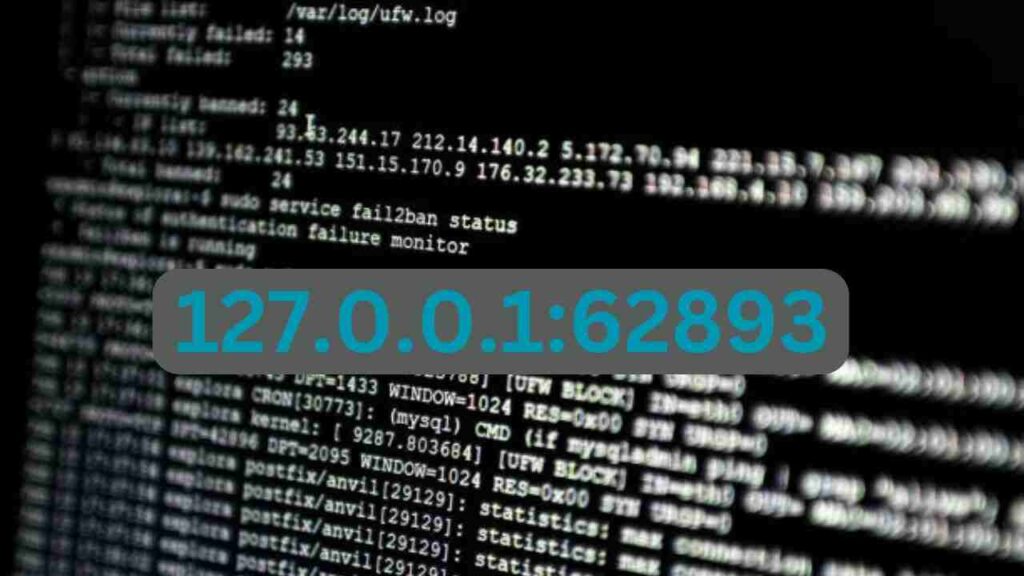If you’re a developer or IT professional, chances are you’ve come across 127.0.0.1, also known as localhost, while working with servers, databases, or network configurations. When you add a port number like 62893, things can get a bit more confusing. So, what exactly is “127.0.0.1:62893 Explained: Troubleshooting Common Errors?” And why do you encounter errors while working with it? In this article, we’ll break down 127.0.0.1:62893, explain common errors associated with it, and provide troubleshooting steps in a way that’s easy to understand.

Understanding 127.0.0.1 and Localhost
Before diving into 127.0.0.1:62893, it’s important to understand the basics of 127.0.0.1. This is a special IP address known as the loopback address or localhost. It refers to the machine you are currently using and allows the computer to communicate with itself without going out to a broader network or the internet.
Imagine this scenario: You’re developing a new web app and you want to test it before deploying it to a live server. Instead of setting up a server on the web, you can run the application locally on your machine using localhost (127.0.0.1). This helps you debug and test your app in a safe, controlled environment.
Port 62893is simply a gateway that handles communication for a specific service running on your computer. Think of ports as doors: while 127.0.0.1 is your home address, 62893 is the specific door a particular service uses to enter and exit. It ensures that different applications running on the same device don’t interfere with each other.
What Exactly is 127.0.0.1:62893?
When you see 127.0.0.1:62893, it means that a service or application on your machine is listening for requests on port 62893 through the localhost address. This configuration is typically used for testing local servers, web applications, and network services without needing internet access.
For example, let’s say you’re developing a web-based calculator app. Instead of deploying it to a live server for every little test, you can run the app locally on 127.0.0.1:62893. You access it by opening your browser and typing 127.0.0.1:62893 into the address bar. It’s fast, convenient, and safe, making it ideal for developers.
Common Errors When Working with 127.0.0.1:62893
Now that you understand 127.0.0.1:62893, let’s talk about the common errors you might encounter when using it. Working with local servers can sometimes be tricky, especially if there are configuration issues or network restrictions. Below are some of the most common problems:
1. Connection Refused Error
Have you ever tried to access 127.0.0.1:62893 and gotten a “Connection Refused” error? This happens when the port you’re trying to access isn’t open, or the service you’re running isn’t properly configured.
Fix:
- Step 1: First, make sure that the service associated with port 62893 is running. If it’s a web app, ensure the server (like Apache or Nginx) is active.
- Step 2: Check your firewall settings. Often, firewalls block traffic on non-standard ports like 62893. Open your firewall settings and allow traffic on this port.
- Step 3: Try restarting the service. Sometimes a simple restart resolves configuration issues.
2. Page Not Loading
If you type in 127.0.0.1:62893 and the page doesn’t load, it could be a misconfiguration or the server might not be pointing to the correct port.
Fix:
- Step 1: Verify that the application you’re trying to access is configured to use port 62893. You can check this in the service’s configuration file.
- Step 2: Make sure that your application server (like Apache, Node.js, or Django) is listening on the correct localhost and port combination.
3. Firewall Blocking the Port
Some corporate or personal firewalls may block non-standard ports like 62893, causing your local service to be inaccessible.
Fix:
- Step 1: Open your firewall settings and look for the option to allow traffic on specific ports.
- Step 2: Add port 62893 to the list of allowed ports, and try accessing 127.0.0.1:62893 again.
4. Service Not Running
If your service isn’t running, the browser will fail to connect to 127.0.0.1:62893, giving you a blank page or a server error.
Fix:
- Step 1: Go to your terminal (or command prompt) and start the service manually.
- Step 2: Use the command
netstat -anto check if port 62893 is in use. If the port isn’t being used, you’ll need to start the application that uses it.
Practical Guide to Troubleshooting 127.0.0.1:62893
Now, let’s walk through a step-by-step guide to troubleshooting common errors with 127.0.0.1:62893.
Step 1: Check if the Service is Running
Before you start troubleshooting, confirm that the service associated with port 62893 is running. For example, if you’re working with a local web server, open your terminal and use the appropriate command to start the server. This could be npm start, apachectl start, or another relevant command.
Step 2: Test Port Accessibility
Once the service is running, you can test if port 62893 is accessible using a command like netstat. Here’s how to do it:
- Windows: Open the Command Prompt and type
netstat -an | find "62893". If you see an entry for 127.0.0.1:62893, that means the port is active and the service is listening. - Mac/Linux: Open the terminal and type
netstat -an | grep "62893". Again, look for 127.0.0.1:62893 in the output.
If the port isn’t active, you’ll need to double-check your service’s configuration.
Step 3: Check Firewall Settings
As we mentioned earlier, firewalls can block non-standard ports. Make sure that your firewall is configured to allow traffic on port 62893. Here’s a quick guide on how to do this:
- Windows Firewall: Go to Control Panel > System and Security > Windows Firewall. Click on Advanced settings and then add an Inbound Rule to allow traffic on port 62893.
- Mac/Linux: Use the
ufwcommand (sudo ufw allow 62893/tcp) to allow the port.
Step 4: Use Localhost in Your Browser
Now that your service is running and the firewall is configured, you should be able to access 127.0.0.1:62893 in your browser. Simply open a new tab and enter http://127.0.0.1:62893.
If the page still doesn’t load, try restarting your computer or resetting your network settings.
Why Is 127.0.0.1:62893 Important for Developers?
For developers, 127.0.0.1:62893 plays a crucial role in local testing and debugging. It allows you to test your applications without deploying them to the internet, offering a safe environment to experiment, debug, and fine-tune your code.
Here’s a quick anecdote to illustrate its importance:
“John, a junior developer, was working on his first-ever web app. Nervously, he launched his local server, and everything seemed perfect. However, the moment he tried to access the app on his company’s live server, nothing worked. After hours of frustration, his senior recommended testing the app locally using 127.0.0.1:62893. John realized his server configuration was faulty, something he could’ve caught earlier had he tested it on localhost first.”
Testing on localhost allows you to avoid these common errors, ensuring your app runs smoothly when deployed.
Boosting Application Security with 127.0.0.1:62893
Not only does 127.0.0.1:62893 help with testing, but it also improves security. By running services on localhost, you limit exposure to external attacks, ensuring only users with access to your machine can interact with the service. This is especially useful during development when you don’t want unfinished features exposed to the public.
Conclusion:
In summary, 127.0.0.1:62893 Explained: Troubleshooting Common Errors is essential knowledge for anyone involved in software development or IT. Understanding how 127.0.0.1 and port 62893 work together can save you hours of frustration and help you develop, test, and secure applications more efficiently.
By following the troubleshooting steps we’ve provided, you’ll be well-equipped to resolve common issues related to 127.0.0.1:62893. Whether you’re a developer testing a web app or someone trying to troubleshoot server connectivity issues, knowing how to navigate localhost is a valuable skill.
So the next time you encounter an error with 127.0.0.1:62893, you’ll know exactly what to do!
Frequently Asked Questions
Here are some more articles recommended for you:
What Is QAAS Technology? A Comprehensive Guide
How to Migrate from AFile to PLM SaaS: A Step-by-Step Guide.
What Is Software As A Service (SAAS)? Everything You Need To Know



